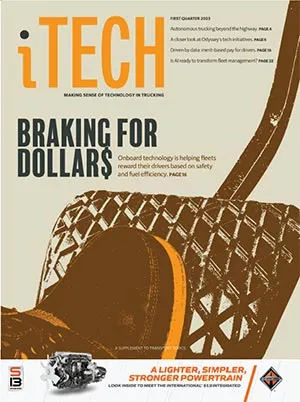Managing Editor, Features
Broader Horizons for Autonomous Trucks

[Find the latest in trucking technology: Explore this quarter's issue of iTECH]
As self-driving truck developers move forward with pilot deployments and continue laying the groundwork for broader commercialization, they are pursuing several different concepts for how and where this technology could fit into real-world freight operations in the coming years.
These companies are not designing their automated driving systems to do everything that a professional driver can do or go everywhere that a human-piloted truck can go. Instead, they are targeting limited business cases that constrain where autonomous trucks will operate, thus reducing the complexity of the task and easing the technology’s path to market.
The most prevalent example is the hub-to-hub model, where autonomous heavy-duty tractors haul goods between two specific locations on predefined routes over long stretches of interstate highways.

Clevenger
But other approaches also have emerged, including box trucks in shorthaul operations, as well as a renewed focus on automating vehicles in restricted areas such as logistics yards and industrial sites.
One of the companies taking a unique approach to autonomous trucking is Gatik. Instead of targeting the longhaul segment, this company is working directly with large shippers to automate shorthaul routes with autonomous box trucks that shuttle goods between fulfillment centers, warehouses and drop-off locations.
This “hyper constrained model” — with fixed, repeatable routes — reduces the technical challenge of autonomy, said Richard Steiner, Gatik’s head of policy and communications.
Q1 iTECH
►Incentivizing Driver Excellence
►Five Questions for Odyssey Logistics' CIO
►Dysart: Tackling AI Fleet Management
►Clevenger: Broader Horizons for Autonomous Trucks
Explore the Issue!
“We need exponentially less data to safely and quickly reach fully driverless — the holy grail of autonomy,” he said during an interview earlier this year at CES 2023 in Las Vegas, where Gatik showcased an Isuzu box truck fitted with its self-driving system.
While Gatik’s initial deployments begin with a safety driver behind the wheel, the company already has pulled the driver from self-driving box trucks that are actively transporting cargo for Walmart in Arkansas and Canadian retailer Loblaw Cos. in Ontario.
In those cases, no one is sitting in the driver’s seat as the trucks move cargo autonomously, but the vehicles do still have a “safety passenger” inside the vehicle at the request of some stakeholders, Steiner said. Those passengers are not required to assume control of the vehicle, nor are they necessary for technical or regulatory reasons, he said, adding that the company aims to eventually remove the safety passenger from the vehicle as well.
Gatik also diverges from other self-driving truck developers in another significant way. Rather than aiming to eventually hand over its autonomous driving technology to fleet operators, the company plans to continue transporting cargo for its customers with its own self-driving vehicles through an “autonomy as a service” model.
“That’s the model we’re going to continue to operate,” Steiner said.
Gatik’s trucks run routes that range from single-digit miles up to about 300, but the sweet spot for many of its customers are in the 50- to 75-mile range, he said.
So far, Gatik has commercially deployed about 40 vehicles that are moving cargo on a daily basis and generating revenue with each delivery for customers in the United States and Canada.
The company is planning to rapidly expand its fleet this year. By the end of 2023, “it’ll be in the hundreds,” Steiner said.
Other automated truck developers are targeting different business opportunities.
Pronto, which had been working to commercialize a highly automated driver-assist system for on-highway trucks, has since pivoted to developing fully autonomous off-road vehicles for mining operations in the past few years.

Joel Morrow of Alpha Drivers Testing & Consulting traveled across America asking one simple question: What if a trucker designed a truck? Hear the program above and at RoadSigns.TTNews.com.
Although specialized autonomous vehicles already have been hauling materials for many years at some large mines across the globe, Pronto sees an opportunity to deploy autonomous trucks more broadly throughout the mining industry, especially at smaller sites, said Ognen Stojanovski, Pronto’s chief operating officer.
“The more we dug into it, the more we learned about the unit economics, and the more we learned about the real desire in the industry, we just started focusing more and more on that,” he said. “It wasn’t as much of a push. It was a lot more of a pull there.”
Pronto is in the early commercialization phase with a handful of pilot deployments in mining operations.
“We’re signing contracts and getting paid for moving dirt every day,” said Stojanovski, who co-founded Pronto alongside autonomous vehicle pioneer Anthony Levandowski.
Want more news? Listen to today's daily briefing above or go here for more info
While Pronto is no longer actively selling or supporting its Copilot driver-assist systems for highway driving, Stojanovski said he is still interested in commercializing Pronto’s technology in the on-highway trucking space in the future.
The experience Pronto is gaining in the off-road vehicle space will help pave the way for a return to the on-road market, not just with driver-assist technology but with fully autonomous driving technology “when the tech is ready for it,” he said.
Pronto also is actively working on a federally funded research project with Virginia Tech focused on how trucking fleets could adopt autonomous driving technology and operate a mix of manually driven and autonomous vehicles.
“I think our tech ultimately is still going to help Class 8 drivers in the long run,” Stojanovski said.





